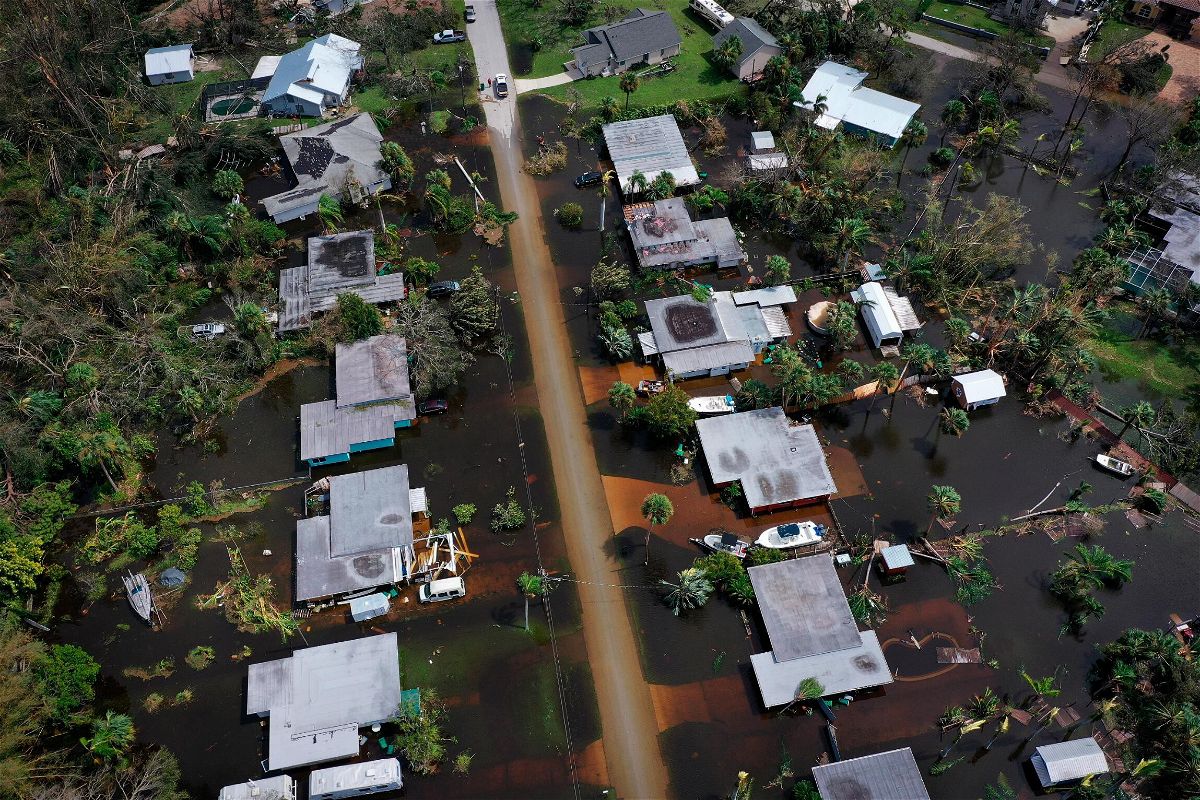What to know about flesh-eating bacteria Vibrio vulnificus, and how to avoid it

In this aerial view
By Jen Christensen, CNN
In the wake of flooding from Hurricane Ian, Lee County, Florida, has seen what the state’s Department of Health called an “abnormal increase” in cases of a rare bacterial infection.
Florida has reported 64 Vibrio vulnificus infections and 13 deaths this year as of Friday, according to the health department, up from 34 cases and 10 deaths last year. This is the first time the number of cases has gone above 50 since 2008, when the state started keeping track.
Many of the cases have been concentrated in Lee County, where residents have been cleaning up after Category 4 Hurricane Ian made landfall at the end of September.
These infections are rare but serious. Vibrio vulnificus causes an estimated 80,000 illnesses and 100 deaths in the United States every year, according to the US Centers for Disease Control and Prevention.
Where does Vibrio come from?
Vibrio vulnificus naturally lives in warm, salty or brackish water. It comes from the same family as the bacteria that causes cholera.
Vibrio can be found in waters around the world. In the US, it lives in the Gulf of Mexico and along some of the coastal waters of the East and West Coasts. The bacteria proliferates in the warmer months, when ocean temperatures are at their highest.
Infections can happen when someone comes into contact with water with large amounts of the bacteria in it or eats contaminated seafood.
What does a skin infection look like?
A mild case of vibriosis typically includes chills, fever, diarrhea, stomach pain and possibly vomiting. Usually, people get sick within the first day of exposure to the bacteria.
Skin wounds infected with Vibrio vulnificus typically develop blisters, abscesses and ulcers.
Vibrio vulnificus is one of the bacteria that can cause what’s commonly known as a flesh-eating infection. Necrotizing fasciitis eats away at the skin, muscles, nerves, fat and blood vessels around an infected wound.
In more severe cases, people can develop septicemia. This is more common for those with underlying health conditions, particularly liver disease, cancer, diabetes, HIV or other diseases that suppress the immune system.
Septicemia is when the bacteria enters the bloodstream and spreads. It can cause fever, chills, low blood pressure or skin blisters.
This may lead to septic shock, when blood pressure takes a dangerous drop. The bacteria releases toxins into the bloodstream that could cause extremely slow blood flow, damaging tissue and organs.
It can also cause sepsis, in which the body mounts a strong immune response that shuts down important organs like the heart or the kidneys. Or it can lead to acute respiratory distress syndrome, or ARDS, a condition in which oxygen from the lungs doesn’t reach the blood. This can cause brain damage and permanent lung damage.
If the infection moves into the bloodstream, the consequences can be fatal.
Typically, the fatality rate is about 25% with wound infections, studies show. It’s much higher for people who are exposed to the bacteria by eating contaminated food.
Infections from contaminated food
Most Vibrio infections in the US generally come not through an infected wound but from eating raw or undercooked seafood like oysters, particularly in the summer months.
The bacteria can live in the bellies of fish, oysters and other shellfish. People can consume the bacteria or be exposed to it when preparing raw seafood.
Vibrio vulnificus infection is the leading cause of death related to eating seafood in the United States. Most of these cases involve primary septicemia, or bacteria in the bloodstream.
How is Vibrio infection treated?
With skin infections, a doctor will first take samples from the infected area to determine if Vibrio vulnificus is what’s causing the problem.
They will drain any abscesses and treat the infected site, sometimes coating the wound with a topical antibiotic and a skin protectant, in addition to other antibiotics. If there’s necrotizing fasciitis, they may have to do surgery or even amputate the affected limb to keep the infection from spreading.
Doctors say it is important to seek treatment quickly. People who get medical attention as soon as they notice an infection respond better to treatment, studies show, and their infections are less likely to become fatal.
However, this particular bacteria has developed some antimicrobial resistance. Up to 50% of Vibrio vulnificus infections don’t respond to certain antibiotics anymore, studies show.
Hurricanes and Vibrio vulnificus
The 28 cases of Vibrio infection associated with Hurricane Ian in Lee County, according to the health department, followed exposure to floodwaters that carried high concentrations of this bacteria into people’s homes. Some may have been exposed while cleaning up after the storm.
Six deaths from Vibrio infection have been reported in Lee County.
Although these infections are still rare, this is not the first time a hurricane has brought a small surge of cases. One spike came after Hurricane Katrina in 2005, according to the US Centers for Disease Control and Prevention, when people were also exposed to Vibrio vulnificus in floodwaters.
Scientists are concerned that infections will continue to rise with climate change. Warmer oceans create a more welcoming environment for the bacteria and increase the frequency of hurricanes — and people’s exposure to floodwaters.
How to prevent infection
The only way to prevent Vibrio infection is to avoid exposure.
If you have a skin wound, even a new tattoo or piercing, doctors suggest that you stay out of the ocean and avoid brackish water, or at least cover the area with waterproof bandages.
If exposed to salt water, the CDC advises that you wash your hands and any cuts thoroughly with soap and water afterward.
If you have to go into the water, as with hurricane cleanup, wear clothes and shoes that protect any cuts or wounds from floodwaters.
You can also reduce your risk of vibriosis by making sure your seafood is well-cooked. Avoid raw or undercooked oysters or other shellfish, and be sure to wash your hands with soap and water after handling raw shellfish.
For cooked shellfish, eat only the ones that open during cooking. For shucked oysters, the CDC recommends boiling, frying or broiling them for at least three minutes or baking them at 450 degrees for 10 minutes.
The-CNN-Wire
™ & © 2022 Cable News Network, Inc., a Warner Bros. Discovery Company. All rights reserved.
CNN’s Carma Hassan contributed to this report.

